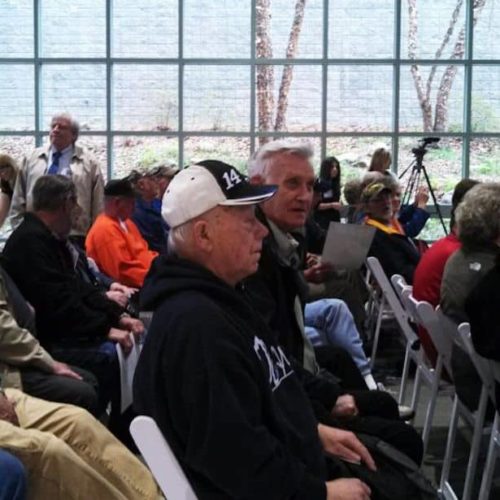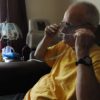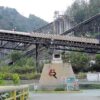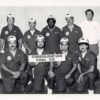Introduction
MORGANTOWN, W.Va. — After almost two decades of reports, hearings, failed proposals and political wrangling, federal regulators on Wednesday announced sweeping changes to protect coal miners from black lung disease.
“This is a historical day for coal miners in this country,” said Joe Main, the head of the Mine Safety and Health Administration, as he looked out at a packed atrium — with at least four dozen miners and family members sitting front and center — at a government research facility here. “We’re issuing a new rule that’s going to change your lives.”
During the announcement, which featured testimonials by individual miners, Main and Labor Secretary Tom Perez outlined the details of the long-awaited rule. It reduces the amount of disease-causing dust allowed in mines, requires new technology that would make possible continuous monitoring of dust levels and closes a host of loopholes that have allowed companies to put workers at risk.
The moment of the occasion was clear Wednesday. Current and former federal health officials filled many of the seats at the research agency’s offices here. Moments before the event began, a long line of miners — some hooked to oxygen tanks to help them breathe — and their family members filed in and took their seats at the front of the room.
The rule comes as government researchers are documenting a resurgence in the fatal, incurable disease that was supposed to have been eradicated years ago. Though disease rates declined in the decades following a landmark 1969 law, government researchers recently have documented a disturbing trend: Since the late 1990s, rates of black lung have been on the rise, and a more aggressive form of the disease has surfaced, increasingly affecting younger miners.
The dust limit set by the final rule is the first reduction since the level set by the 1969 law.
Yet the limit does not go as far as the agency’s initial proposal, cutting the benchmark by one quarter instead of one half. “This rule demonstrates that we heard the concerns from the industry,” Perez said after the announcement, addressing questions about the middle ground the agency chose.
Nonetheless, the industry criticized the rule. The National Mining Association issued a statement calling the rule “disappointing” and said experts had determined the new standards “cannot be met by existing technologies.”
Murray Energy Corp., which is one of the nation’s largest coal companies and is led by the outspoken and politically active coal magnate Robert Murray, said Wednesday it planned to sue the Obama administration over the “disastrous and politically motivated rule … which fails to protect coal miners and destroys jobs.”
The push for reform that led to Wednesday’s announcement has a long and tortured history. The National Institute for Occupational Safety and Health, the government research agency known as NIOSH, reviewed a number of studies and concluded in a 1995 document that the dust limit set by the 1969 law should be cut in half. In the final years of the Clinton administration, however, reform attempts stalled.
The most recent push began in December 2009 when MSHA announced a campaign to end black lung. The agency released a proposal in October 2010, then held hearings and took public comments for much of 2011. Last August, MSHA sent the proposal to the White House’s Office of Management and Budget for review and approval. It has been stuck there until this week.
At every step, the coal industry and its allies have sought to delay or kill the rule. In comments to the agency, trade groups and major companies have argued that the rule is not supported by scientific evidence and that it would have grave economic effects.
House Republicans have requested two studies on the rule, with the first being tied to an appropriations bill that would block implementation until the study was complete. Both studies found that the rule was scientifically well-grounded.
When the rule went to the White House’s budget office, industry representatives twice met with officials. Members of the United Mine Workers of America also met once with the White House officials.
On Wednesday, Main and Perez stressed the portions of the rule meant to close loopholes in the current regulatory system, many of which were described in a report by the Center and NPR in 2012. In 2013, another Center series, Breathless and Burdened, described how coal industry lawyers and doctors helped beat back miners’ claims for benefits; one part of the series was produced in partnership with ABC News.
Under existing rules, miners wear pumps that collect samples of the amount of dust in the air, but coal companies get to average five samples, meaning some miners could be exposed to dangerously high dust levels as long as they are balanced by lower exposures to other miners. Samples are taken over an eight-hour period, even though many miners now work 10- or 12-hour shifts.
When an inspector is conducting sampling, companies are allowed to operate at half of normal production levels, generating less dust than likely would be present at full production. When MSHA does issue a citation, companies often have been allowed to avoid fixing the underlying problems for weeks or even months, potentially leaving miners exposed to high dust levels.
The new rule allows MSHA to issue a citation if any individual miner’s sample is too high, mandates sampling over a full shift, requires companies to operate at 80 percent of normal production levels during sampling and gives the agency authority to order quick fixes of violations and step up enforcement efforts at mines that appear to be cutting corners.
The changes to address sampling problems take effect this August. By February 2016, companies will have to use continuous personal dust monitors, which will provide miners with real-time information about the amount of dust they are breathing.
Miners have long described what they viewed as rampant cheating of dust samples. Documents and interviews with current and former miners have revealed practices such as supervisors placing pumps in clean air or tampering with pumps after sampling. The use of the continuous monitors should make such practices much more difficult, Main said Wednesday.
The final stage of the rule — the reduced dust limit — will take effect August 1, 2016.
The rule also expands the government’s X-ray surveillance program to include surface miners, who now will be eligible for the free tests. Emerging research from NIOSH shows that workers above ground also are suffering from black lung at significant rates. Further, all miners now will be eligible for free lung function tests.
The statement from Murray Energy Corp. called the continuous monitors “unproven, unreliable [and] subject to tampering.” Main contended that their use was supported by testing conducted by NIOSH. Overall, the requirements of the rule are not feasible technologically or economically, both Murray Energy Corp. and the National Mining Association said.
“I’ve heard people say we should wait and study this more,” Perez said. “We have, quite literally, studied the issue to death. … We have the tools to prevent this devastating disease. Now it’s time to muster the will to do it.”
U.S. Sen. Jay Rockefeller, who has been a longtime advocate for miners and recently announced he would not seek re-election, received a standing ovation and spoke of the new rule as a crucial step in the continuing fight to secure better working conditions for miners.
“I think we are making history here, but you have to watch us,” he said. “It’s one thing to make an announcement. It’s another thing to make it work. … The coal companies will fight this with everything they have.”
Carol Miller, who lost her husband Ronald to black lung, spoke, as did former miner Gary Hairston, who fought back tears as he described being unable to play with his grandson because of breathing problems caused by black lung.
But perhaps most stark was the one sentence uttered by former miner Dewey Keiper, who struggled to breathe and gasped as he spoke to the audience: “I worked in the mines for 28 years, never had any serious injuries, and now I can’t work no more.” He dropped his head, unable to continue.
“That’s why I took this job,” the normally reserved Main said, choking up. “Many of us in this room today began on this journey years ago, and we didn’t give up. … This rule finally makes good on the promise Congress made 40 years ago.”
Read more in Environment
Environment
EPA plan would slash climate-damaging carbon emissions from 1,000 existing power plants
Breathless and Burdened
Labor Department unveils rule to protect coal miners following Center investigation
‘Big step’ to ensure sick miners have access to key evidence about their cases.






Join the conversation
Show Comments